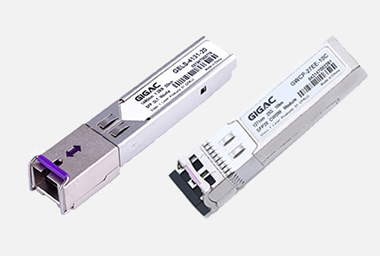The main differences between dual fiber SFP optical modules and single fiber SFP optical modules are reflected in the following aspects:
Transmission mechanism and number of ports: The dual fiber SFP optical module adopts a bidirectional transmission mechanism and has two independent channels or ports, one for sending data and the other for receiving data. In contrast, single fiber SFP optical modules adopt a unidirectional transmission mechanism A port that separates sending and receiving data through different wavelengths.
Fiber optic utilization: In dual fiber SFP optical modules, both sending and receiving require an independent fiber optic connection. The single fiber SFP optical module achieves bidirectional transmission of transmission and reception through a single fiber, which is particularly economical in scenarios with limited fiber resources.

Wavelength range: Common wavelengths for dual fiber SFP optical modules include 850nm, 1310nm, and 1550nm. The wavelength range of single fiber SFP optical modules varies between 1300nm and 1600nm.
Transmission distance: 1G SFP optical modules use single-mode and multi-mode optical fibers to transmit data. Using multimode optical fibers, the data transmission distance of 1G SFP optical modules can reach 2km, while single-mode SFP optical modules can reach 160km. For BIDI single fiber SFP optical modules, they can be used in conjunction with OS2 optical cables or multimode fiber optic cables. The transmission distance is usually between 2km and 120km.
Paired use: The dual fiber 1G SFP optical module operates at wavelengths of 850nm, 1310nm, and 1550nm. All SFP optical modules must be used in pairs. For common SFP optical modules, two SFP optical modules with the same wavelength should be connected together. For example, if an 850nm SFP optical module is used on one end, then an 850nm SFP optical module must also be used on the other end
Deployment cost: The dual fiber optical module requires the use of two optical fibers, which increases the cost of fiber optic wiring and maintenance difficulty during deployment. Single line optical module: Only one fiber is needed, which can reduce the cost and management complexity of fiber optic wiring.
There are significant differences between dual fiber SFP optical modules and single fiber SFP optical modules in terms of transmission mechanism, number of ports, fiber utilization, and wavelength range. These differences give them their respective advantages and applicability in different application scenarios. The common dual fiber SFP optical module uses two optical fibers for data transmission, while the duplex optical module uses one optical fiber for transmission. After clearly understanding the differences in transmission distance, fiber utilization, and usage methods, it is also necessary to consider costs and future network requirements to Make the right choice.


